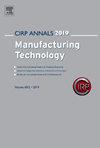Directional factor as the key factor for chatter free robotic milling of light alloys
IF 3.6
3区 工程技术
Q2 ENGINEERING, INDUSTRIAL
引用次数: 0
Abstract
Robotic milling systems are increasingly used for light alloys and composites, but face challenges due to high dynamic flexibility of robots. A key issue is low-frequency chatter, linked to the robot's structural modes during high-speed operations. Therefore, this study deals with a dominant flexible mode with high tooth-passing frequencies, highlighting the influence of the directional factor. Negative directional factors can cause low-frequency chatter at high spindle speeds. Polar stability lobes show that optimal feed direction and radial engagement zones align with positive directional factors. The study shows that slotting operations assure a chatter free machining. Experimental validation confirms theoretical findings.
方向因素是影响轻合金无颤振铣削的关键因素
机器人铣削系统越来越多地用于轻合金和复合材料,但由于机器人的高动态灵活性而面临挑战。一个关键问题是低频颤振,这与机器人在高速运行时的结构模式有关。因此,本研究研究了具有高齿通过频率的主导柔性模式,突出了方向因素的影响。负方向因素会在高主轴转速下引起低频颤振。极性稳定叶表明,最佳进给方向和径向啮合区与正方向因子对齐。研究表明,开槽可保证无颤振加工。实验验证证实了理论发现。
本文章由计算机程序翻译,如有差异,请以英文原文为准。
求助全文
约1分钟内获得全文
求助全文
来源期刊

Cirp Annals-Manufacturing Technology
工程技术-工程:工业
CiteScore
7.50
自引率
9.80%
发文量
137
审稿时长
13.5 months
期刊介绍:
CIRP, The International Academy for Production Engineering, was founded in 1951 to promote, by scientific research, the development of all aspects of manufacturing technology covering the optimization, control and management of processes, machines and systems.
This biannual ISI cited journal contains approximately 140 refereed technical and keynote papers. Subject areas covered include:
Assembly, Cutting, Design, Electro-Physical and Chemical Processes, Forming, Abrasive processes, Surfaces, Machines, Production Systems and Organizations, Precision Engineering and Metrology, Life-Cycle Engineering, Microsystems Technology (MST), Nanotechnology.
 求助内容:
求助内容: 应助结果提醒方式:
应助结果提醒方式:


